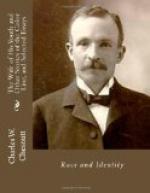The recital of her wrongs had wrought upon aunt Milly’s feelings so that her voice broke, and she wiped her eyes with her apron.
The elder looked serenely confident, and moved his chair nearer hers in order the better to play the role of comforter. Wellington, on the outside, felt so mean that the darkness of the night was scarcely sufficient to hide him; it would be no more than right if the earth were to open and swallow him up.
“An’ yet aftuh all, elder,” said Milly with a sob, “though I knows you is a better man, an’ would treat me right, I wuz so use’ ter dat ole nigger, an’ libbed wid ’im so long, dat ef he ‘d open dat do’ dis minute an’ walk in, I ’m feared I ‘d be foolish ernuff an’ weak ernuff to forgive ‘im an’ take ’im back ag’in.”
With a bound, uncle Wellington was away from the crack in the wall. As he ran round the house he passed the wood-pile and snatched up an armful of pieces. A moment later he threw open the door.
“Ole ’oman,” he exclaimed, “here ‘s dat wood you tol’ me ter fetch in! Why, elder,” he said to the preacher, who had started from his seat with surprise, “w’at’s yo’ hurry? Won’t you stay an’ hab some supper wid us?”
The Bouquet
Mary Myrover’s friends were somewhat surprised when she began to teach a colored school. Miss Myrover’s friends are mentioned here, because nowhere more than in a Southern town is public opinion a force which cannot be lightly contravened. Public opinion, however, did not oppose Miss Myrover’s teaching colored children; in fact, all the colored public schools in town—and there were several—were taught by white teachers, and had been so taught since the State had undertaken to provide free public instruction for all children within its boundaries. Previous to that time, there had been a Freedman’s Bureau school and a Presbyterian missionary school, but these had been withdrawn when the need for them became less pressing. The colored people of the town had been for some time agitating their right to teach their own schools, but as yet the claim had not been conceded.
The reason Miss Myrover’s course created some surprise was not, therefore, the fact that a Southern white woman should teach a colored school; it lay in the fact that up to this time no woman of just her quality had taken up such work. Most of the teachers of colored schools were not of those who had constituted the aristocracy of the old regime; they might be said rather to represent the new order of things, in which labor was in time to become honorable, and men were, after a somewhat longer time, to depend, for their place in society, upon themselves rather than upon their ancestors. Mary Myrover belonged to one of the proudest of the old families. Her ancestors had been people of distinction in Virginia before a collateral branch of the main stock had settled in North Carolina. Before the war, they had been




